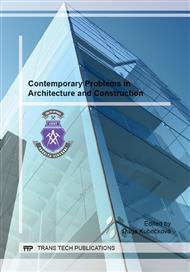p.411
p.415
p.423
p.429
p.435
p.441
p.447
p.451
p.457
Temperature Monitoring on the Final Tunnel Lining
Abstract:
Modern tunnel structures are presently implemented primarily by conventional excavation, using the New Austrian Tunneling Method. Two linings are usually used to support the excavated area. The primary tunnel lining serves for consolidation of the extracting during tunneling and the secondary tunnel lining ensures the safe use of the structure during its life time. The design and evaluation of the tunnel lining is a comprehensive process that involves a lot of input conditions. We are not always able to define these inputs exactly. In order to specify the amount of secondary lining load, we must know not only the load by the rock but also e.g. the hydrostatic load and deformation behavior of concrete during its aging. The lining is also influenced by local climatic conditions. It is necessary to include effects of various temperatures on the lining in our design. The measurements carried out in the already completed structures serve us for a more exact determination of these temperatures. Based on the results from these measurements, we can determine the distribution of temperatures in the profile and the behavior of the construction versus the climate change more exactly. Monitoring the temperature development takes a long time. The specification of this behavior should lead to a material saving when new constructions are designed.
Info:
Periodical:
Pages:
435-440
Citation:
Online since:
October 2014
Authors:
Keywords:
Price:
Сopyright:
© 2014 Trans Tech Publications Ltd. All Rights Reserved
Share:
Citation:


